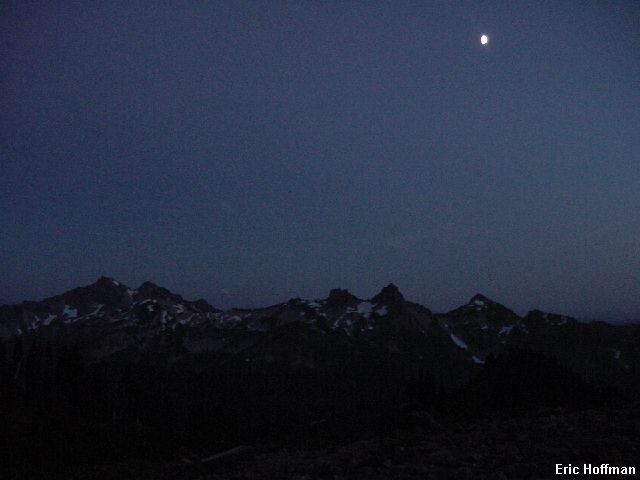The Tatoosh Range

Andy and I had been weighing the advantages and disadvantages of a high camp on some of Rainier's shorter, easier routes for a while now. What it boiled down to was was it worth it to carry a 50 or 60 pound pack half way up the mountain with a few hours of rest as a reward? Maybe, maybe not. There was only one way to know for sure.
I got off work a bit early and met Andy at 4:00pm in Federal Way. Friday traffic prompted us to reach the mountain via Enumclaw and Highway 410. We got a permit at the White River Ranger Station. With no high camp, there were no applicable quotas to hamper the effort. After obtaining the permit, we headed to the Stevens Canyon entrance and reached Paradise a little after 7:00pm. Around 8:15pm we began a 14+ hour journey to the summit of Rainier and back.
We began the hike to Pebble Creek. The weather was excellent, the views great. The moon was bright enough that we could negotiate our way up most of the Muir Snowfield without the use of headlamps. We arrived at Camp Muir around 11:30pm, where we found teams in various stages of preparing to start up the mountain.
|
The Tatoosh Range |
|
|
|
Mount Rainier from near Glacier Vista |
|
|
At Camp Muir we took about a 45 minute break to eat, drink, rope-up and in what little time was left, rest. An obviously inexperienced team of climbers left Muir just before midnight. After the team left we waited about 20 minutes before stepping onto the Cowlitz Glacier at 12:15pm. We arrived at Cathedral Gap where the team the team ahead of us was trying to figure out what to do next. We took advantage of the opportunity to get ahead of them and continued on to Ingrahm Flats. There were three teams below the icefall...not moving. We decided to take a break until they started moving. When they finally did move, one team came down and the other teams started traversing towards the ledge where Disappointment Cleaver is gained (c.11,300'). We started up, crossed below the icefall and passed the barely moving teams, who had not yet reached the cleaver. The lower cleaver is snow free but higher up on the left side there is plenty of snow remaining but it was severely suncupped and tedious if you got out of the 2 foot deep trough/path. We arrived at the top of the cleaver (c.12,300') and took a long break. We had already climbed nearly 7,000 of the 9000 feet between Paradise and the summit and it was only 2:15am.
Somewhere around 3:20am we awoke to the sounds of two teams of climbers, then a "solo" climber. We gathered our belongings and started up and came to a fork in the path. To the left or to the right? The left had a wand marking it, so I went left...until I reached a crevasse. We traversed right, crossing through a small icefall until we reached the correct path. Following the path we end ran, or crossed a few crevasses to c.13,300' where we took another break. It was starting to get light in the east. The "solo" climber was with us most of the way and continued past us. After our break we started out, the route traversing between two crevasses until the one above could be end run, then the path came to another fork. No wands marking the way, and even if there had been, I took what seemed to be the less direct route, thinking this was a way around a crevasse problem in the path heading straight toward the crater rim. As it turned out, this was not the ideal route but we made it work and arrived at the crater rim. It was just before 6:00am and just before sunrise.
|
A tired Andy Johnson reaches the crater rim |
|
|
|
Liberty Cap and Puget Sound |
|
|
|
Andy crossing the crater in the nieve penitentes |
|
|
After visiting all the summit destinations, we began the descent. A number of other teams were on their way to the top. Beyond Camp Muir, it was non-stop people. We arrived at Paradise a little before 11:00am, nearly 15 hours after leaving. I suppose the lingering question is, was it worth it? Yes and no. We were able to do the climb with little planning (no permit problems) and I wasn't too much more exhausted than I would have been after a two day climb. One thing to consider is that we had great weather on this trip. The same trip under different conditions could be no fun at all. The other problem is the dramatic altitude change in such a short period of time. No doubt a combination of the altitude, the physical activity, and the lack of sleep, food and water, both Andy and I noticed the altitude more on this trip than on our previous trips, all of which were two or more days in duration. If nothing else it was something different the standard route to the summit of Rainier.